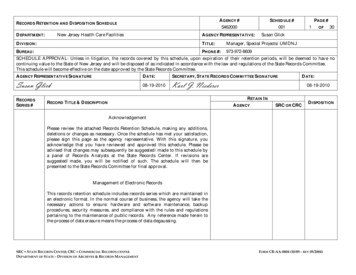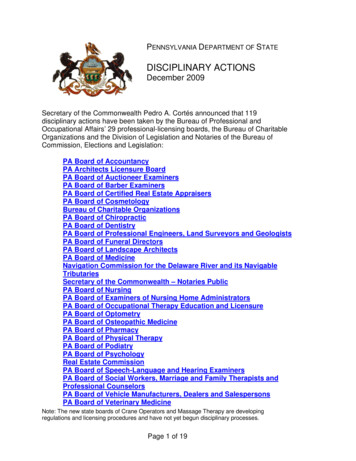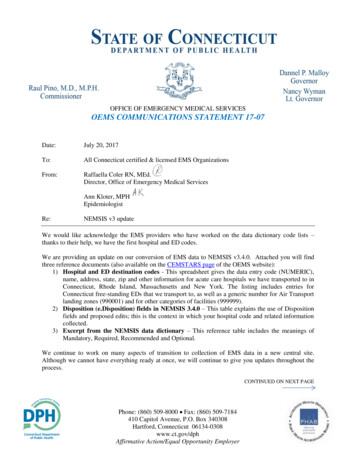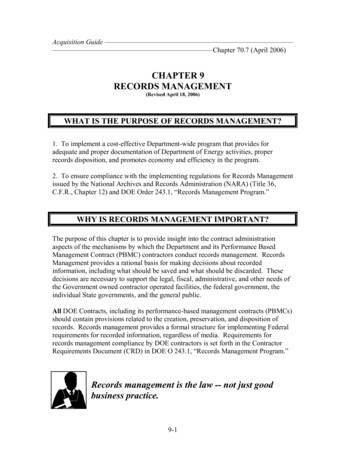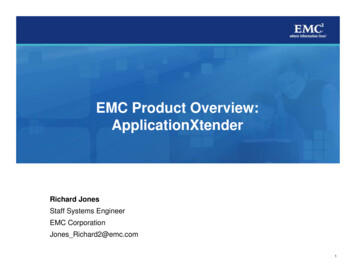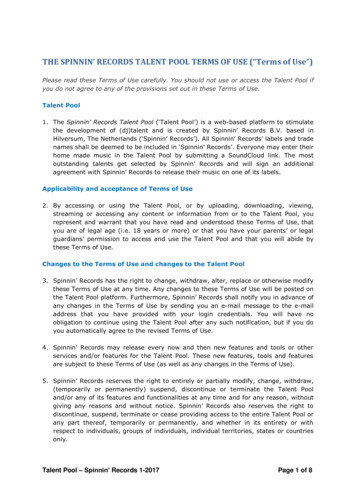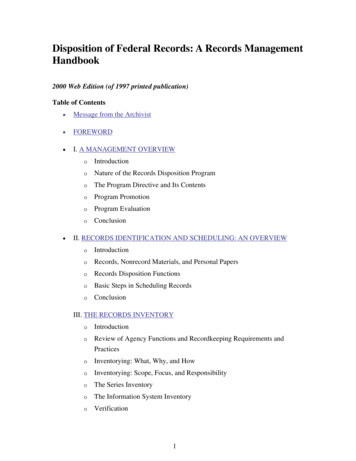
Transcription
Disposition of Federal Records: A Records ManagementHandbook2000 Web Edition (of 1997 printed publication)Table of Contents Message from the Archivist FOREWORD I. A MANAGEMENT OVERVIEW oIntroductionoNature of the Records Disposition ProgramoThe Program Directive and Its ContentsoProgram PromotionoProgram EvaluationoConclusionII. RECORDS IDENTIFICATION AND SCHEDULING: AN OVERVIEWoIntroductionoRecords, Nonrecord Materials, and Personal PapersoRecords Disposition FunctionsoBasic Steps in Scheduling RecordsoConclusionIII. THE RECORDS INVENTORYoIntroductionoReview of Agency Functions and Recordkeeping Requirements andPracticesoInventorying: What, Why, and HowoInventorying: Scope, Focus, and ResponsibilityoThe Series InventoryoThe Information System InventoryoVerification1
oConclusionIV. RECORD VALUES AND SCHEDULE INSTRUCTIONoIntroductionoEvaluating Records: The Agency's ViewpointoEvaluating Records: NARA's ViewpointoPreparing Disposition InstructionsoUnderstanding General Records SchedulesoApplying General Records Schedules to Agency RecordsoConclusionV. SCHEDULE PREPARATION AND CLEARANCEoIntroductionoCompleting an SF 115oDescription and Added InformationoElectronic, Audiovisual, and Other Special RecordsoOther Considerations in Completing an SF 115oArranging a Records ScheduleoAssembling a Draft Records ScheduleoObtaining Internal Clearances and GAO's ApprovaloSubmitting an SF 115 for NARA's ApprovaloConclusionVI. SCHEDULE IMPLEMENTATIONoIntroductionoIssuing the ScheduleoTraining EmployeesoApplying the Schedule to Permanent RecordsoApplying the Schedule to Temporary RecordsoReviewing and Updating the ScheduleoRelated Disposition MattersoConclusionVII. PROGRAM EVALUATION2
oIntroductionoReports on the ProgramoSelf-Evaluation GuidelinesoNARA's Evaluation of Agency ProgramsoConclusionAPPENDIX A. RECORDS DISPOSITION STATUTESo44 U.S.C. Chapter 21o44 U.S.C. Chapter 29o44 U.S.C. Chapter 31o44 U.S.C. Chapter 33o18 U.S.C. Chapter 101APPENDIX B. RECORDS DISPOSITION REGULATIONS (36 CFR 1228)oSubpart A: Records Disposition ProgramsoSubpart B: Scheduling RecordsoSubpart C: General Records SchedulesoSubpart D: Implementing SchedulesoSubpart E: Loan of Permanent and Unscheduled RecordsoSubpart F: Emergency Authorization to Destroy RecordsoSubpart G: Damage to, Alienation, and Unauthorized Destruction ofRecordsoSubpart H: Transfer of Records from the Custody of One ExecutiveAgency to AnotheroSubpart I: Transfer of Records to Records Storage FacilitiesoSubpart J: Transfer, Use, and Disposition of Records in a NARA RecordsCenteroSubpart K: Facility Standards for Records Storage FacilitiesoSubpart L: Transfer of Records to the National Archives of the UnitedStatesoAppendix A to Part 1228 - Minimum Security Standards for Level IIIFederal Facilities3
oAppendix B to Part 1228 - Alternative Certified Fire-safety Detection andSuppression System(s) Authority: 44 U.S.C. chs. 21, 29, and 33.APPENDIX C. APPRAISAL GUIDELINES FOR PERMANENT RECORDSAPPENDIX D. RECORDS MANAGEMENT PUBLICATIONSAPPENDIX E. LIST OF REGIONAL RECORDS SERVICES FACILITIESFrom the ArchivistThis web-formatted version of the 1997 reprint of the Disposition of Federal Recordshandbook has been changed only to update organizational information and reflectchanges in regulations.As indicated in the National Archives and Records Administration's Strategic Plan,Ready Access to Essential Evidence, we are reviewing our records management policies.This handbook and other records management issuances will be more extensively revisedin the future for conformance to changes in policy and in recordkeeping practicesaffected by technological developments.Please let me know if you have suggestions for improving this handbook or any of ourother records management publications.JOHN W. CARLINArchivist of the United StatesFOREWORDAn effective records disposition program is the key to successful records management inFederal agencies. It helps ensure that agencies have the recorded information necessary toconduct Government business, avoid waste, and preserve America's documentaryheritage.This handbook explains how to establish, manage, and operate a records dispositionprogram within a Federal agency. It emphasizes the necessity of each agency'sdeveloping, implementing, and updating a records schedule for all agency records,4
regardless of media or location. Developing a records schedule includes reviewingagency functions and recordkeeping requirements, inventorying and evaluating records,preparing disposition instructions, organizing and clearing the schedule internally, andobtaining approval from the National Archives and Records Administration (NARA) and,if necessary, from the General Accounting Office (GAO).Proper implementation involves issuing the approved records schedule as an agencydirective, training employees to use it, and carefully applying the schedule's provisions toboth permanent and temporary records. The schedule's final objective is to ensure theauthorized, appropriate, and timely disposition of the agency's records. Besides beingdeveloped and implemented, the schedule needs to be reviewed at least annually andupdated whenever necessary.The handbook explains how to evaluate a records disposition program in order to makeimprovements. It also describes NARA's role in helping agencies comply with laws andregulations regarding records disposition and other aspects of records management. Theappendixes contain relevant laws and regulations, appraisal guidelines for permanentrecords, a listing and description of NARA's records management publications, and a listof regional records facilities. The frequent repetitions, summaries, and cross-referencesare intended to facilitate use of this edition for instructional purposes as well as for selfstudy.This handbook does not cover the disposition of Presidential records or records of theU.S. Congress.Richard A. Wire wrote this revised edition of Disposition of Federal Records. He wishesto thank Frank B. Evans, William H. Leary, and Katherine V. Coram for their advice andassistance. This publication was designed and illustrated by John H. Hedges.Bibliographic note: The 2000 web edition is based on the 1997 printed publicationDisposition of Federal Records, a Records Management Handbook, Second Edition,National Archives and Records Administration, Office of Records Services -Washington, D.C. (1997). The web edition may vary from the printed version. The texthas been changed to update organizational information and reflect changes in regulations.5
I. A Management Overview Introduction Nature of the Records Disposition Program The Program Directive and Its Contents Program Promotion Program Evaluation ConclusionI. A Management Overview An effective records disposition program is essential to successful recordsmanagement, which is an integral part of information resources management. A disposition program requires a strong directive. Managing the records disposition program includes training employees,publicizing the program, and cultivating professional relationships. Agency records officers should participate in the development of electronic andother recordkeeping systems to ensure proper planning for disposition. Agency records officers need to evaluate their records disposition programsperiodically.IntroductionThis chapter describes how to establish and manage a records disposition program, whilethe following chapters explain how to implement it. An effective records dispositionprogram is the key to successful records management, which, in turn, ensures thatGovernment activities are documented properly, efficiently, and economically. ManagingFederal records requires an understanding of their essential role in administeringGovernment affairs and of the relationship of records management to other informationresources management programs. It also entails a knowledge of recordkeepingrequirements. Managing the disposition program is based on a directive establishing theprogram and involves an understanding of the program's nature, of promotion methods,and of evaluation techniques.Records and Information Resources Management6
Managing recorded information is an important responsibility of every Federal agency.As the basic administrative tool by which the Government does its work, records are abasic component of each agency's information resources. Like other resources, they mustbe managed properly for the agency to function effectively and comply with Federal lawsand regulations.According to Federal law (44 U.S.C. 2901), records management means:the managerial activities involved with respect to records creation, records maintenanceand use, and records disposition in order to achieve adequate and proper documentationof the policies and transactions of the Federal Government and effective and economicalmanagement of agency operations.Along with data processing and telecommunications, records management is an integralpart of information resources management (IRM). (See fig. 1-1.) IRM is concerned withthe creation, maintenance and use, and disposition of information as well as with relatedresources, or assets, such as personnel, equipment, funds, and technology. In accordancewith 44 U.S.C. 3504, the Office of Management and Budget (OMB) works with theNational Archives and Records Administration (NARA) and the General ServicesAdministration (GSA) to promote the coordination of Federal information policy,including records management. (For more details on OMB's role in IRM, see OMBCircular No. A-130, Management of Federal Information Resources.)7
s.Flguire 1-1. IRM ComponentsIn setting forth records management responsibilities, Federal law requires each agencyhead tomake and preserve records containing adequate and proper documentation of theorganization, functions, policies, decisions, procedures, and essentialtransactions of the agency and designed to furnish the information necessary toprotect the legal and financial rights of the Government and of persons directlyaffected by the agency's activities [44 U.S.C. 3101].The agency head must also "establish and maintain an active, continuing program for theeconomical and efficient management of the records of the agency" (44 U.S.C. 3102).This means establishing continuous and systematic control over the creation,maintenance and use, and disposition of agency records in accordance with statutory andregulatory requirements. It also involves cooperating with NARA and GSA to improverecords management.Recordkeeping RequirementsCentral to the proper management of recorded information is the concept ofrecordkeeping requirements. These requirements are statements in laws, regulations, oragency directives providing general and specific guidance on particular records to be8
created and maintained by an agency. Since each agency is legally obligated to create andmaintain adequate and proper documentation of its organization, functions, and activities,it needs to issue recordkeeping requirements for all activities at all levels and for allmedia and to distinguish records from nonrecord materials and personal papers.Agency recordkeeping requirements apply to both the creation and maintenance ofrecords. In accordance with NARA regulations (36 CFR 1222), these requirementsshould prescribe the systematic creation and maintenance of all agency records.Records Disposition and the Life Cycle of RecordsDisposition is an integral part of records management and is the third and final stage ofthe life cycle of records. According to the life cycle concept, records go through threebasic stages: (1) creation (or receipt), (2) maintenance and use, and (3) disposition. (Seefig. 1-2.) Although this handbook focuses on disposition, all three stages of the recordslife cycle are interrelated. Thus an agency must coordinate its programs to managerecords creation, maintenance and use, and disposition so that each program supports theothers.Records CreationRecords Maintenanceand UseRecords DispositionFigure 1-2. The Records Life CycleIn Federal usage, records are referred to, depending on the stage they have reached intheir life cycle, as "current," "semicurrent," or "noncurrent." These terms refer not to thedate or age of the records, but rather to their use in the current daily work of the office.9
As used in this handbook, disposition means those actions taken regarding Federalrecords after they are no longer needed in office space to conduct current agencybusiness. These actions include: Transfer of records to agency storage facilities or NARA records centers. Transfer of records from one Federal agency to another. Transfer of permanent records to the National Archives of the United States. Disposal of temporary records no longer needed to conduct agency business,usually by destruction or occasionally by donation.Disposition is a comprehensive term that includes destruction as well as other actions,such as the transfer of permanent records to the National Archives. After appraisingagency records, NARA authorizes either their disposal or their transfer to the NationalArchives for preservation and research. Agencies must also receive NARA's approvalbefore lending records outside the Federal Government, before retiring them to NARAoperated record centers, and before transferring them to other Federal agencies, unlessexceptions have been granted. Finally, they must receive NARA's approval beforeestablishing or relocating their records centers and before converting permanent orunscheduled originals to microfilm.In contrast to disposition, "disposal" in Federal usage refers to only those final actionstaken regarding temporary records after their retention periods expire. It normally meansdestruction of the record content, such as by recycling or burning the record medium. Theterm is also used occasionally to mean the transfer of temporary records from Federalcontrol by donating them to an eligible person or organization after receiving NARA'sapproval.Nature of the Records Disposition ProgramDefinitionA records disposition program may be defined as those policies and practices designed toachieve effective and efficient disposition by scheduling all records; ensuring their properstorage, whether in agency or record center storage space; ensuring the authorized andprompt disposal of temporary records; and ensuring the timely transfer of permanentrecords to the National Archives.10
Elements of the ProgramThe primary steps in managing a records disposition program are described below andsummarized in figure 1-3. These steps make up the elements of the program: Issue a program directive assigning authorities and responsibilities for recordsdisposition activities in the agency, and keep that directive up to date. Develop, implement, and update a comprehensive records schedule. Train all those taking part in the agency's records disposition activities. Publicize the program to make all agency employees aware of their recordsdisposition responsibilities. Evaluate the results of the program to ensure adequacy, effectiveness, andefficiency.Issue a Program Directiv,e2 De ,elop. Implement., and Update a R.ecords Soheduiienatn EmployeesP'r-ogram5. EvaJual!e ih,e ResultsThis chapter describes the steps involving the program directive, training, publicity, andevaluation. Later chapters elaborate on developing, implementing, and updating acomprehensive records schedule and on evaluating a records disposition program.Basic ObjectivesA records disposition program provides for the effective and efficient management ofrecords no longer needed in office space to conduct current business. It has three mainobjectives: The prompt disposal of temporary records whose authorized retention periodshave expired, the timely and systematic transfer to economical storage of records nolonger needed in office space but not yet eligible for final disposition, and the11
identification and transfer of permanent records to the National Archives for preservationand for reference and research use.Most records cannot and should not be kept permanently or even for long periods. Allrecords, regardless of media, fall into one of two categories for disposition purposes:1. Temporary records. These should be destroyed, or in rare instances donated,after a fixed period of time or after occurrence of a specified event. The time mayrange from a few months to many years. Most Federal records are temporary.2. Permanent records. These are sufficiently valuable for historical or otherpurposes to warrant continued preservation by the Federal Government.Relatively few Federal records are permanent, although the exact percentagediffers from agency to agency.In carrying out a records disposition program, each agency is responsible forrecommending to NARA retention periods for potentially temporary records and suitabletransfer dates for potentially permanent records. The agency also needs to determinewhere the records should be kept as they await disposal or transfer to the NationalArchives -- in the office, in an agency storage facility, or in a commercial or NARArecord center.The Program Directive and Its ContentsManagerial SupportTo establish an effective records disposition program, the agency head must issue astrongly worded directive making the program an integral part of the agency's recordsand information management program. Issuing this directive emphasizes the agency'scommitment to the authorized, timely, and orderly disposition of records. It allows theagency to issue the proper delegations of authority, establish staffing patterns, andapprove procedures. The sections that follow provide details about the directive and itscontents.Organizational PlacementThe organizational placement of the records disposition program will influence itseffectiveness. In deciding where to place the program, the agency must recognize it as an12
important management function and understand the need to relate it to other records andinformation management programs.Program Responsibility and ObjectivesThe directive should designate the agency records officer as the official responsible forthe program. It should permit delegation of authority to involve all parts of the agency inthe program. The most important part of the directive states these program aims andduties: To enable agency managers to make informed decisions. To establish effective controls over all records and nonrecord materials in theagency's custody. To prepare, obtain approval of, and apply an up-to-date comprehensive schedulefor all agency records and nonrecord materials. To participate in the development of electronic and other recordkeeping systemsto ensure proper disposition. To assist and advise agency officials regarding records disposition matters. To act as a liaison with NARA for program direction. To recruit and train the staff necessary to carry out the program. To evaluate the program's results to ensure adequacy, effectiveness, andefficiency.Staffing and LiaisonThe directive should provide for an adequate network of personnel at major headquartersoffices and at field offices to carry on records disposition work under the agency recordsofficer's direction. The number of people in this liaison group depends on the size of theagency and its organizational complexity. Figure 1-4 illustrates the structure of such asystem.Smaller agencies may find that records officers must directly conduct dispositionactivities. In a larger agency, the complexity and volume of records often requireassigning some people full-time to the disposition function.13
AgeniRecor sOfficer.,r ''Division, Bureau,Office LiaisonOfficers'.Field OfficeLiaisonOfficers. ,. FilesCustodians .r""I'""Flgure 1-4. Liaison OrganizationNARA's RoleThe directive should indicate NARA's role in the disposition program. It should identifyNARA as the oversight agency responsible for appraising all Federal records, approvingtheir disposition, providing program assistance and records center storage, evaluatingrecords management programs, and serving as the final custodian of permanent records.It should also point out that NARA operates two different types of records facilities: NARA records centers. These provide temporary storage and also referenceservice for records that are needed infrequently by the creating agency but are notyet eligible for disposal or transfer to the National Archives. Records stored in aNARA records center remain in the legal custody of the creating agency. The National Archives. It stores the Federal Government's permanent records,which are also known as the National Archives of the United States. Whentransferring permanent records to the National Archives, agencies also transferlegal custody of the records. The National Archives takes conservation measuresneeded to preserve the records and also provides reference service, includingservice to the creating agency.Finally, if the directive covers the entire records management program, it should alsoindicate the responsibilities of GSA, OMB, and other oversight agencies.14
Program PromotionIn working to develop and apply a comprehensive records schedule, the agency needs topromote and evaluate the overall records disposition program. Program promotioninvolves training employees, publicizing the program, helping develop and monitorelectronic and other recordkeeping systems, and cultivating professional relationshipsinside and outside the agency.TrainingProper training is an essential part of a records disposition program. Training shouldinvolve those agency personnel directly concerned with developing and applyingschedules. These individuals include the agency records officer and staff, records liaisonofficers in central and field offices, and files custodians.NARA's introductory records disposition curriculum provides a basis for internal agencytraining. In addition, records officers and their staffs can keep current by participating inmore advanced training offered by NARA. These training opportunities are provided byNARA's Office of Records Services - Washington, DC and the Office of RegionalRecords Services. These and other training opportunities are described on the NARARecords Management Programs training web page.Agencies should periodically brief supervisors and other employees on their recordsresponsibilities, particularly those relating to records disposition. Audiovisual recordingsof training and briefing sessions may also be useful, especially for remote locations orregional offices.Publicizing the ProgramBesides formal training courses and briefing sessions, other ways to publicize the recordsdisposition program include:Agency Newsletters. These are a valuable way of informing employees about theprogram.15
Posters. Appropriate posters are available for display on office walls or in hallways. Forelectronic copies of other records management posters, see the NARA recordsmanagement publications web page.Our·enuncnl ,.sg,;:,odi Records can taker ,- -man:,.rrorms: -.\:::-. . ··- : ;' . l1-:---- ',.lf 1Ci.-eate 1-ecot:ds l,h.at Y l'J and odl.ers n Cd ro do2.,"lake care or}fOtilJ:rds.blllSin12SS.IF OR MORE,INFORMATION:1!1 11:sk )'Ollrwpcn(lm See )'Ollll' rooDll'.lB ollb:li!r19 Wri o:rcall lbeNatlona/1 AR:Nl'fflf R0::ams A.dmilili51mtloll - Oi:a!'cr 1 :1rtl1.C lroomi11i;ihict RECOJ'I' U!Mli.o .}fl!di )'l!IJl' or w!Ahyow- reooro.s pa::,,bl,m .N':!.tioml .r\rehi-iro:, ani.l IRlids,Adm.imlil:mU!m.I .(!(' ,!\(uai, l!'I, n JnCom1niwnCl!ruerW DG20400' f l 203-72-1-M'HDeveloping and Monitoring Recordkeeping SystemsAgency records officers should participate in the design and development ofrecordkeeping systems to ensure the proper disposition of recorded information. Suchinvolvement is especially important in the design of electronic records systems.16
According to OMB Circular No. A-130, agencies are to create or collect information"only after planning for its . . . use, storage, and disposition."The uncontrolled purchase of recordkeeping equipment can waste money and underminethe entire records disposition program. Records officers should review requests for majorpurchases of such equipment to ensure that the records are scheduled and the dispositioninstructions are being carried out promptly.Cultivating Professional RelationshipsRecords officers need to develop and maintain good professional relationships bothinside and outside the agency in order to advance records disposition and other aspects ofrecords management. They should develop and maintain such relationships with: Records liaison officers. An active network of such officers, both at headquartersand in the field, is essential to the success of the agency's records dispositionprogram. As those responsible for coordinating records matters in particularoffices, records liaison officers provide the agency's records officer with much ofthe information and support needed to develop and implement the program. Agency program managers. Involving them is essential to the dispositionprogram's success. They must be consulted to determine the value of the recordsto the agency and to identify other users and uses of the information. Theirinvolvement will help ensure that records officers participate in the developmentof new information systems. Assisting these managers in disposition and otherrecords management matters can open doors to cooperation. Furthermore, therecords disposition program offers program managers an important service. Itprovides the disposition authorities required to preserve the information they needto do their jobs well and to dispose of information when it is no longer needed. Designers and managers of electronic records systems. Because of the growthof such systems, records officers should give special attention to helping designand develop these systems to ensure adequate documentation and especiallyproper disposition of recorded information. Agency historians. Records officers should assist agency historians and consultwith them in the process of ensuring adequate documentation and identifyingrecords with potentially permanent value.17
Records managers outside the agency. Forming a network of contacts outsidethe agency can be useful. Attending meetings sponsored by NARA andprofessional societies, for example, can lead to a sharing of information and ideasabout records management problems and possible solutions. For informationabout professional societies as well as NARA-sponsored meetings, agenciesshould contact NARA's Life Cycle Management Division. Information aboutNARA events is also available on the records management web page. NARA staff members. NARA staff members are a key resource as agenciesdevelop or improve their records disposition programs. Besides approvingmandatory disposition authorities, NARA provides services such as information,training, and record center storage. It also takes legal custody of permanentrecords once their agency use has ended, as described in later chapters of thishandbook.Program EvaluationGood management necessarily involves evaluating a program's results to makeimprovements such as shorter retention periods for temporary records, more timelydisposal or transfer of eligible records, and better relations with other agency managersand NARA.Besides reviewing its records schedule annually, each agency is required to evaluateperiodically its records management programs, including records disposition, forcompliance with relevant laws and regulations and for effectiveness. Likewise, in itsoversight role, NARA periodically conducts single agency and interagency evaluationsfor the same purposes. (36 CFR 1220)Chapter VII of this handbook contains further information on evaluating an agency'srecords disposition program.Conclusion18
An effective records disposition program is the key to successfully managing recordedinformation. Such a program helps ensure that agencies have the recorded informationnecessary to conduct Government business, avoid waste, and preserve America'sdocumentary heritage for transfer to the National Archives. Managing this program is achallenging and rewarding responsibility, one that deserves the highest priority.After giving an overview of identifying and scheduling records, the chapters that followexplain how to carry out a records disposition program, especially by developing andimplementing a comprehensive records schedule and by evaluating the program.19
II. Records Identification and Scheduling: An Overview Introduction Records, Nonrecord Materials, and Personal Papers Records Disposition Functions Basic Steps in Scheduling Records ConclusionII. Records Identification and Scheduling: An Overview Records must be identified and distinguished from nonrecord materials andpersonal papers. Records are created or received and accumulated as an agency conductsGovernment business. Records may be on paper, electronic, audiovisual, microform, or other media. Scheduling is the process of developing a document that provides mandatoryinstructions for what to do with records (and nonrecord materials) no longerneeded for current Government business. The scheduling process requires an understanding of records dispositionfunctions. Basic scheduling steps include reviewing agency functions and recordkeepingrequirements, inventorying and evaluating the records, and preparing dispositioninstructions. The steps also include organizing the draft schedule, clearing it internally andexternally, and then implementing the approved schedule and updating itwhenever necessary.IntroductionAn effective records disposition program depends, at least in part, on the systematiccreation and maintenance of agency records. Records management during the creationand maintenance stages involves identifying records and establishing and meetingrecordkeeping requirements.
Disposition is an integral part of records management and is the third and final stage of the life cycle of records. According to the life cycle concept, records go through three basic stages: (1) creation (or receipt), (2) maintenance and use, and (3) disposition. (See . fig. 1-2.) Although this handbook focuses on disposition, all three .



